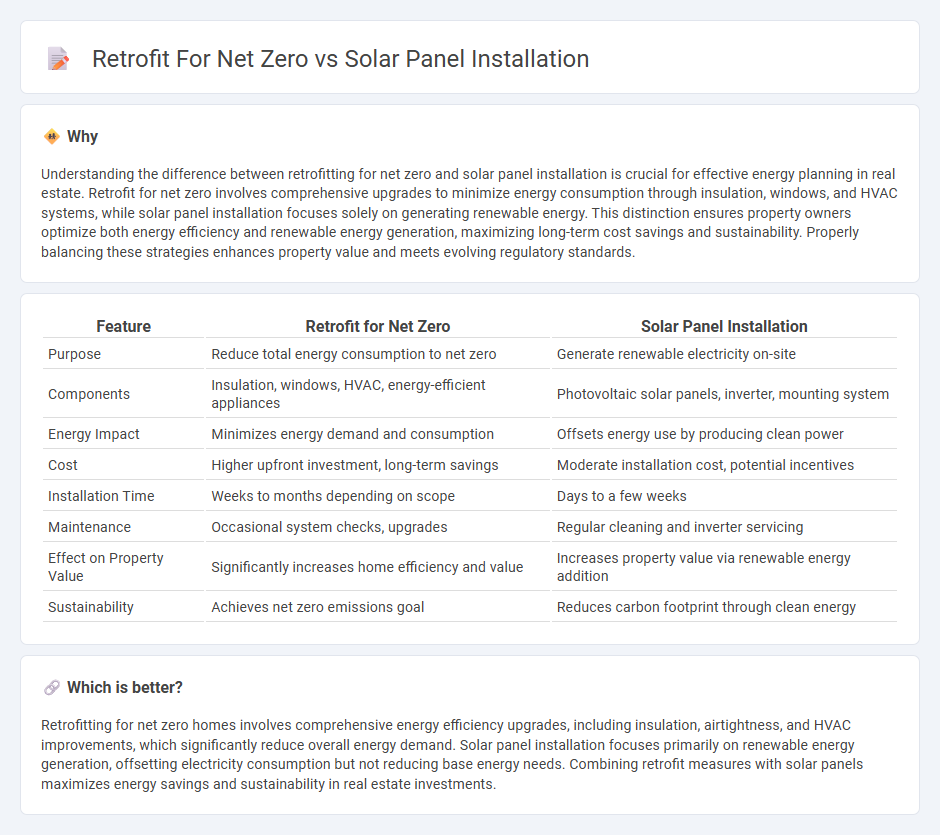
Retrofitting for net zero focuses on comprehensive energy efficiency improvements, including insulation, airtightness, and advanced HVAC systems, to minimize a building's energy consumption and achieve carbon neutrality. Solar panel installation primarily generates clean electricity but does not address the underlying energy demand, making it a complementary rather than standalone solution. Explore deeper insights into optimizing retrofits and solar integration for sustainable real estate projects.
Why it is important
Understanding the difference between retrofitting for net zero and solar panel installation is crucial for effective energy planning in real estate. Retrofit for net zero involves comprehensive upgrades to minimize energy consumption through insulation, windows, and HVAC systems, while solar panel installation focuses solely on generating renewable energy. This distinction ensures property owners optimize both energy efficiency and renewable energy generation, maximizing long-term cost savings and sustainability. Properly balancing these strategies enhances property value and meets evolving regulatory standards.
Comparison Table
| Feature | Retrofit for Net Zero | Solar Panel Installation |
|---|---|---|
| Purpose | Reduce total energy consumption to net zero | Generate renewable electricity on-site |
| Components | Insulation, windows, HVAC, energy-efficient appliances | Photovoltaic solar panels, inverter, mounting system |
| Energy Impact | Minimizes energy demand and consumption | Offsets energy use by producing clean power |
| Cost | Higher upfront investment, long-term savings | Moderate installation cost, potential incentives |
| Installation Time | Weeks to months depending on scope | Days to a few weeks |
| Maintenance | Occasional system checks, upgrades | Regular cleaning and inverter servicing |
| Effect on Property Value | Significantly increases home efficiency and value | Increases property value via renewable energy addition |
| Sustainability | Achieves net zero emissions goal | Reduces carbon footprint through clean energy |
Which is better?
Retrofitting for net zero homes involves comprehensive energy efficiency upgrades, including insulation, airtightness, and HVAC improvements, which significantly reduce overall energy demand. Solar panel installation focuses primarily on renewable energy generation, offsetting electricity consumption but not reducing base energy needs. Combining retrofit measures with solar panels maximizes energy savings and sustainability in real estate investments.
Connection
Retrofitting buildings for net zero energy involves improving insulation, sealing air leaks, and upgrading HVAC systems to drastically reduce energy consumption, making solar panel installations more effective by decreasing overall demand. Solar panels contribute by generating renewable electricity on-site, offsetting the remaining energy use after retrofit measures are applied. Combining net zero retrofits with solar energy integration maximizes energy efficiency and sustainability in real estate properties.
Key Terms
Energy Efficiency
Solar panel installation on new builds offers peak energy efficiency by integrating optimal placement and advanced photovoltaic technology from the outset, maximizing solar gain and minimizing energy loss. Retrofit solar panel systems enhance existing structures' energy efficiency by upgrading older inefficient components and optimizing panel layout, though they may face constraints due to roof orientation and shading. Explore detailed comparisons and tailored solutions to achieve net zero energy goals efficiently.
Building Envelope
Solar panel installation on new builds integrates seamlessly with the building envelope, optimizing energy efficiency and enhancing net zero potential through better insulation and airtightness. Retrofit projects require careful assessment of existing structural and thermal properties to minimize energy losses and ensure compatibility with the building's envelope, maximizing solar energy benefits. Discover detailed strategies to optimize solar panel integration in both new and retrofit scenarios for achieving net zero energy goals.
Renewable Integration
Solar panel installation involves integrating new photovoltaic systems during initial construction, optimizing design for maximum energy output and seamless renewable integration in net zero buildings. Retrofit solar solutions adapt existing structures, presenting unique challenges in electrical compatibility and energy storage but enabling enhanced sustainability without full redesign. Explore more on solar strategies to achieve efficient renewable integration in net zero projects.
Source and External Links
A Complete Guide on How to Install a Solar Panel at Home - This guide details a 7-step process including setting up scaffolding, installing mounts, and securing panels, emphasizing safety and preparation for a successful solar panel installation.
How Much Does It Cost to Install Solar Panels Yourself? - Installing solar panels yourself is feasible with proper tools and knowledge, involving securing mounts and electrical wiring, though professional help is recommended for complex setups.
How to Install Solar Panels in 2025 - The solar installation process includes an engineering site visit, permits, ordering equipment, installation, and utility interconnection, with a recommendation to hire professionals rather than DIY.
 dowidth.com
dowidth.com